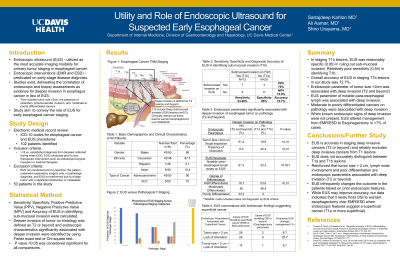Back


Poster Session D - Tuesday Morning
Category: Interventional Endoscopy
D0448 - Utility and Role of Endoscopic Ultrasound for Suspected Early Esophageal Cancer
Tuesday, October 25, 2022
10:00 AM – 12:00 PM ET
Location: Crown Ballroom

Has Audio

Sartajdeep Kahlon, MD
University of California Davis
Sacramento, CA
Presenting Author(s)
Sartajdeep Kahlon, MD1, Ali Aamar, MD2, Zeeshan Butt, MD3, Shiro Urayama, MD4
1University of California Davis, Sacramento, CA; 2UC Davis Medical Center, Sacramento, CA; 3Integrated Medical Care Hospital, Lahore, Punjab, Pakistan; 4University of California, Davis, Sacramento, CA
Introduction: Accurate clinical staging of esophageal cancer is vital in selecting appropriate treatment options. Endoscopic ultrasound (EUS) has been determined to be an accurate imaging modality for esophageal cancer staging, differentiating superficial lesions from deep lesions. Despite being accurate, utilization of EUS in apparent early-stage cancer remains controversial. The current study aims to assess the utility of EUS for early-stage esophageal cancer and whether endoscopic features of esophageal malignancy can help direct the optimal management of the cancer.
Methods: This was a retrospective study of patients who underwent pre-resection EUS after a diagnosis of esophageal cancer at a tertiary medical center. 50 patients met inclusion criteria for this study. Patient clinical data, initial EGD/biopsy, EUS, and final resection pathology reports were extracted from chart review and statistical analysis was performed to determine the accuracy of EUS and associations of endoscopic findings with deeper invasion.
Results: EUS T stage was concordant with histological T stage in 74% of patients (37/50). In determining sub-mucosal involvement (T1a vs T1b), EUS had a specificity of 85% and sensitivity of 53.8%. EUS had an overall accuracy of 72.7% in identifying sub-mucosal invasion in T1 cancers. Prominent lymph nodes on EUS and tumor size >2 cm on visual inspection were significantly associated with deeper invasion of cancer on histology with p-values < 0.01. Barrett’s morphology was significantly associated with superficial cancers with a p-value < 0.01. EUS affected management from EMR/ESD to esophagectomy in 9.4% of patient with Barrett’s morphology and 6.7% of patients with tumor size < 2cm. In patients without any endoscopic findings suggestive of deep invasion, EUS identified deeper cancer and changed management in < 7% of cases.
Discussion: For assessing deeper invasion (T2, T3 and T4), EUS has been substantiated as a significantly effective tool. In staging T1b lesions, EUS was reasonably specific in ruling out sub-mucosal invasion; however, it had relatively poor sensitivity in identifying sub-mucosal invasion. Additionally, data validated endoscopic features suggesting superficial cancers including a tumor size < 2cm and the presence of Barrett’s morphology. In patients with these findings suggesting superficial cancer, EUS rarely identified a deep cancer that warranted a change in management.
Disclosures:
Sartajdeep Kahlon, MD1, Ali Aamar, MD2, Zeeshan Butt, MD3, Shiro Urayama, MD4. D0448 - Utility and Role of Endoscopic Ultrasound for Suspected Early Esophageal Cancer, ACG 2022 Annual Scientific Meeting Abstracts. Charlotte, NC: American College of Gastroenterology.
1University of California Davis, Sacramento, CA; 2UC Davis Medical Center, Sacramento, CA; 3Integrated Medical Care Hospital, Lahore, Punjab, Pakistan; 4University of California, Davis, Sacramento, CA
Introduction: Accurate clinical staging of esophageal cancer is vital in selecting appropriate treatment options. Endoscopic ultrasound (EUS) has been determined to be an accurate imaging modality for esophageal cancer staging, differentiating superficial lesions from deep lesions. Despite being accurate, utilization of EUS in apparent early-stage cancer remains controversial. The current study aims to assess the utility of EUS for early-stage esophageal cancer and whether endoscopic features of esophageal malignancy can help direct the optimal management of the cancer.
Methods: This was a retrospective study of patients who underwent pre-resection EUS after a diagnosis of esophageal cancer at a tertiary medical center. 50 patients met inclusion criteria for this study. Patient clinical data, initial EGD/biopsy, EUS, and final resection pathology reports were extracted from chart review and statistical analysis was performed to determine the accuracy of EUS and associations of endoscopic findings with deeper invasion.
Results: EUS T stage was concordant with histological T stage in 74% of patients (37/50). In determining sub-mucosal involvement (T1a vs T1b), EUS had a specificity of 85% and sensitivity of 53.8%. EUS had an overall accuracy of 72.7% in identifying sub-mucosal invasion in T1 cancers. Prominent lymph nodes on EUS and tumor size >2 cm on visual inspection were significantly associated with deeper invasion of cancer on histology with p-values < 0.01. Barrett’s morphology was significantly associated with superficial cancers with a p-value < 0.01. EUS affected management from EMR/ESD to esophagectomy in 9.4% of patient with Barrett’s morphology and 6.7% of patients with tumor size < 2cm. In patients without any endoscopic findings suggestive of deep invasion, EUS identified deeper cancer and changed management in < 7% of cases.
Discussion: For assessing deeper invasion (T2, T3 and T4), EUS has been substantiated as a significantly effective tool. In staging T1b lesions, EUS was reasonably specific in ruling out sub-mucosal invasion; however, it had relatively poor sensitivity in identifying sub-mucosal invasion. Additionally, data validated endoscopic features suggesting superficial cancers including a tumor size < 2cm and the presence of Barrett’s morphology. In patients with these findings suggesting superficial cancer, EUS rarely identified a deep cancer that warranted a change in management.
Disclosures:
Sartajdeep Kahlon indicated no relevant financial relationships.
Ali Aamar indicated no relevant financial relationships.
Zeeshan Butt indicated no relevant financial relationships.
Shiro Urayama: Olympus – Consultant.
Sartajdeep Kahlon, MD1, Ali Aamar, MD2, Zeeshan Butt, MD3, Shiro Urayama, MD4. D0448 - Utility and Role of Endoscopic Ultrasound for Suspected Early Esophageal Cancer, ACG 2022 Annual Scientific Meeting Abstracts. Charlotte, NC: American College of Gastroenterology.

